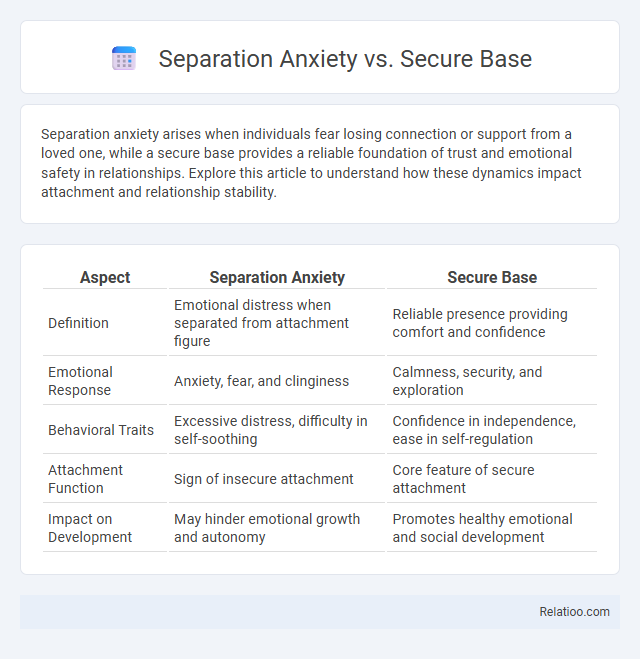Separation anxiety arises when individuals fear losing connection or support from a loved one, while a secure base provides a reliable foundation of trust and emotional safety in relationships. Explore this article to understand how these dynamics impact attachment and relationship stability.
Table of Comparison
| Aspect | Separation Anxiety | Secure Base |
|---|---|---|
| Definition | Emotional distress when separated from attachment figure | Reliable presence providing comfort and confidence |
| Emotional Response | Anxiety, fear, and clinginess | Calmness, security, and exploration |
| Behavioral Traits | Excessive distress, difficulty in self-soothing | Confidence in independence, ease in self-regulation |
| Attachment Function | Sign of insecure attachment | Core feature of secure attachment |
| Impact on Development | May hinder emotional growth and autonomy | Promotes healthy emotional and social development |
Understanding Separation Anxiety: Definition and Causes
Separation anxiety is characterized by excessive fear or distress when separated from attachment figures, often rooted in developmental stages or traumatic experiences. A secure base refers to a caregiver's reliable presence that fosters a child's confidence to explore the environment, reducing the likelihood of severe separation anxiety. Understanding separation anxiety involves recognizing its causes, including genetic predisposition, insecure attachment, and significant changes in routine or caregiving.
What Is a Secure Base? Attachment Theory Explained
A secure base refers to a caregiver's dependable presence that allows a child to explore their environment confidently while knowing they can return for comfort and safety. Separation anxiety occurs when a child experiences distress due to being apart from this secure base, highlighting the importance of a strong attachment relationship. Understanding that your secure base provides emotional support helps mitigate separation anxiety and fosters healthy emotional development in attachment theory.
Key Differences Between Separation Anxiety and Secure Base
Separation anxiety is a psychological condition characterized by excessive fear or distress when separated from primary caregivers, often manifesting in children as crying, clinginess, or tantrums. A secure base refers to the caregiver's presence that provides a child with confidence to explore the world while knowing they can return to safety when needed. Understanding these key differences helps you recognize that separation anxiety denotes distress, whereas a secure base supports healthy emotional development and independence.
Developmental Milestones: Separation Anxiety in Children
Separation anxiety typically emerges between 6 to 12 months and peaks around 18 months, marking a critical developmental milestone in infant emotional growth. A secure base, often provided by a consistent caregiver, helps your child explore the environment confidently while returning for comfort and reassurance. Understanding these stages allows you to support your child's emotional regulation and foster healthy attachment during separation anxiety phases.
The Role of Secure Base in Emotional Development
The secure base provides a consistent source of comfort and safety that allows your child to explore their environment confidently, reducing feelings of separation anxiety. This emotional foundation fosters resilience and healthy attachment patterns crucial for emotional development. Understanding the distinction between separation anxiety and secure base helps caregivers support children's emotional growth effectively.
Signs and Symptoms: Separation Anxiety vs Secure Base
Separation anxiety manifests through excessive distress when apart from attachment figures, including clinginess, nightmares, and physical complaints like stomach aches. In contrast, a secure base provides emotional safety, allowing Your child to explore confidently while returning for reassurance without overwhelming fear. Recognizing these signs helps differentiate healthy attachment behaviors from anxiety-driven distress, supporting better emotional development and well-being.
Long-term Impacts: Unresolved Separation Anxiety
Unresolved separation anxiety in early childhood can result in long-term emotional difficulties such as chronic anxiety, difficulty trusting others, and impaired social relationships. A secure base, established through consistent caregiver responsiveness, supports healthy emotional regulation and resilience, reducing the risk of persistent anxiety disorders. Without a secure base, separation anxiety may escalate into adult attachment issues and increased vulnerability to mental health conditions like depression and generalized anxiety disorder.
How a Secure Base Helps Reduce Separation Anxiety
A secure base, typically provided by a consistent caregiver, offers emotional safety that helps reduce separation anxiety in children by fostering trust and confidence during moments of separation. This supportive foundation enables children to explore their environment without excessive fear, as they trust the caregiver will return. Research shows that children with a secure base display fewer signs of distress and exhibit healthier emotional regulation compared to those with high separation anxiety.
Parental Strategies: Fostering a Secure Base Relationship
Parental strategies for fostering a secure base relationship involve consistent responsiveness and emotional availability, which help alleviate your child's separation anxiety by promoting trust and security. Establishing routines and gently encouraging independence reinforce the child's confidence to explore while knowing they can return to a reliable and comforting caregiver. These practices differentiate secure base support from separation anxiety by reducing distress and strengthening the child's emotional resilience.
When to Seek Help: Managing Separation Anxiety and Promoting Security
When managing separation anxiety, recognizing persistent distress beyond typical developmental stages is crucial for timely intervention. Secure base behavior, characterized by a child using a caregiver as a reliable source of comfort and safety, supports emotional regulation and resilience. Seek professional help if separation anxiety disrupts daily functioning, causes extreme distress, or persists despite consistent secure attachment strategies, as early support promotes long-term emotional security.

Infographic: Separation Anxiety vs Secure Base
 relatioo.com
relatioo.com